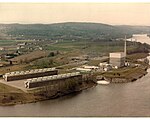Hinsdale, New Hampshire
1753 establishments in the Thirteen ColoniesAC with 0 elementsHinsdale, New HampshireNew Hampshire populated places on the Connecticut RiverPopulated places established in 1753 ... and 2 more
Towns in Cheshire County, New HampshireTowns in New Hampshire

Hinsdale is a town in Cheshire County, New Hampshire, United States. The population was 3,948 at the 2020 census. Hinsdale is home to part of Pisgah State Park in the northeast, and part of Wantastiquet Mountain State Forest in the northwest. The main village in town, where 1,485 people resided at the 2020 census, is defined as the Hinsdale census-designated place (CDP) and is located at the junction of New Hampshire routes 119 and 63.
Excerpt from the Wikipedia article Hinsdale, New Hampshire (License: CC BY-SA 3.0, Authors, Images).Hinsdale, New Hampshire
Northfield Road,
Geographical coordinates (GPS) Address Nearby Places Show on map
Geographical coordinates (GPS)
| Latitude | Longitude |
|---|---|
| N 42.786111111111 ° | E -72.486388888889 ° |
Address
Northfield Road
Northfield Road
03451
New Hampshire, United States
Open on Google Maps







